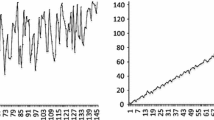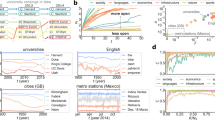Abstract
The reproducibility of the results of university ranking systems and the problem of how to climb in rankings have been discussed in the literature for a long time. We created the simulation software WURS which can be a useful tool to shed light on these discussions. In this paper, we present the features and usage of WURS.









Similar content being viewed by others
References
Adler, N. J., & Harzing, A. W. (2009). When knowledge wins: Transcending the sense and nonsense of academic rankings. Academy of Management Learning & Education,8(1), 72–95.
ARWU. (2018). Academic ranking of world universities. Accessed July 19, 2019, from http://www.shanghairanking.com/ARWU-Methodology-2018.html.
Bollen, K., Cacioppo, J. T., Kaplan, R., Krosnick, J., & Olds, J. L. (2015). Social, behavioral, and economic sciences perspectives on robust and reliable science. Report of the Subcommittee on Replicability in Science Advisory Committee to the National Science Foundation Directorate for Social, Behavioral, and Economic Sciences. Accessed July 19, 2019, from https://www.nsf.gov/sbe/AC_Materials/SBE_Robust_and_Reliable_Research_Report.pdf.
Bougnol, M. L., & Dula, J. H. (2013). A mathematical model to optimize decisions to impact multi-attribute rankings. Scientometrics,95, 785–796.
Bowman, N. A., & Bastedo, M. N. (2011). An anchoring effect on assessments of institutional reputation. Higher Education,61(4), 431–444.
Cano, A. F., Marin, E. C., Rodrigues, M. T., & Ruiz, M. V. (2018). Questioning the Shanghai Ranking methodology as a tool for the evaluation of universities: An integrative review. Scientometrics,116(3), 2069–2083.
Daraio, C., Bonaccorsi, A., & Simar, L. (2015). Rankings and university performance: A conditional multidimensional approach. European Journal of Operational Research,244(3), 918–930.
Dill, D., & Soo, M. (2005). Academic quality, league tables, and public policy: A cross-national analysis of university ranking systems. Higher Education,49(4), 495–533.
Docampo, D. (2013). Reproducibility of the Shanghai academic ranking of world universities results. Scientometrics,94(2), 567–587.
Florian, R. V. (2007). Irreproducibility of the results of the Shangai academic ranking of world universities. Scientometrics,72(1), 25–32.
Goodman, S. N., Fanelli, D., & Ioannidis, J. P. A. (2016). What does research reproducibility mean? Science Translational Medicine,8(341), 12.
Hazelkorn, E. (2008). Learning to live with league tables and ranking: The experience of institutional leaders. Higher Education Policy,21, 193–215.
InCites. (2013). Thomson Reuters. http://incites.isiknowledge.com/. New address: Clarivate Analytics. https://incites.clarivate.com.
Ioannidis, J. P. A., Patsopoulos, N. A., Kavvoura, F. K., Tatsioni, A., Evangelou, E., & Kouri, I. (2007). International ranking systems for universities and institutions: A critical appraisal. BioMed Central Medicine,5, 30.
Johnes, J. (2018). University rankings: What do they really show? Scientometrics,72(1), 25–32.
Longden, B. (2011). Ranking indicators and weights. In J. C. Shin, R. K. Toutkoushian, & U. Teichler (Eds.), University rankings: Theoretical basis, methodology and impacts on global higher education (pp. 73–104). Dordrecht: Springer.
Marginson, S., & Wende, V. D. M. (2007). To rank or to be ranked: The impact of global rankings in higher education. Journal of Studies in International Education,11(3–4), 306–329.
Matthews, A. P. (2012). South African universities in world rankings. Scientometrics,92(3), 675–695.
Peng, R. D. (2011). Reproducible research in computational science. Science,334, 1226–1227.
QS. (2019). QS world university rankings. Accessed July 19, 2019, from https://www.topuniversities.com/qs-world-university-rankings/methodology.
Shehatta, I., & Mahmood, K. (2016). Correlation among top 100 universities in the major six global rankings: Policy implications. Scientometrics,109(2), 1231–1254.
THE. (2019). THE world university rankings. Accessed July 19, 2019, from https://www.timeshighereducation.com/world-university-rankings/methodology-world-university-rankings-2019.
Tofallis, C. (2012). A different approach to university rankings. Higher Education,63(1), 1–18.
Author information
Authors and Affiliations
Corresponding author
Rights and permissions
About this article
Cite this article
Siniksaran, E., Satman, M.H. WURS: a simulation software for university rankings—software review. Scientometrics 122, 701–717 (2020). https://doi.org/10.1007/s11192-019-03269-8
Received:
Published:
Issue Date:
DOI: https://doi.org/10.1007/s11192-019-03269-8




